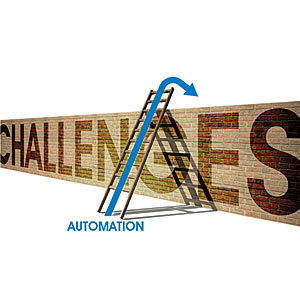As a second-generation contractor, my journey started more than 30 years ago as an estimator and project manager in the wall and ceiling industry. Not long ago, our trade dealt with light and heavy gauge framing, rated and non-rated drywall, and simple ceiling systems. Today, it includes installation of extremely complex systems, both built on-site and prefabricated in special facilities. It’s an extremely competitive trade, but armed with the right automation tool companies can maintain a competitive edge over others in the trade.
Quick Review of Part 1
In case you missed Part 1 of this series, I would like to take a brief moment to bring you up to speed on the topics discussed. To enhance productivity, reduce waste and increase profits, wall and ceiling contractors have always invested in technology and equipment, both in the office and on the jobsite. Prior to digital technologies, the tools used for takeoff and estimating consisted of a scale, colored pencils, highlighters, ledger pads and a calculator.
However, the industry realized that manual processes are both time and labor intensive. Many companies are turning towards automation to solve business problems, reduce inefficiencies and increase productivity to remain competitive. Let’s continue our discussion to see how initial investment in technology can benefit your company in the long run.
Reduce Redundancy & Increase Efficiencies
Digital takeoff and estimating applications quickly pay for themselves in several ways—first by increasing the number of jobs a company bids to win more work; second by eliminating the need to print, handle and store bulky paper plans and other documents; and third by improving the estimator’s ability to analyze the project and organization of their takeoff and estimate.
Digital plans and designs imported into the applications allow an estimator to takeoff all aspects of the project including window, door and MEP cutouts and ceiling track layouts. Because the estimator specifies and views individual conditions directly on the computer screen, it’s easy to work up precise drywall and ceiling counts, types and quantities to develop accurate estimates that meet the design requirements.
Estimators can maintain and manage a library of common assemblies and ceiling and wall designs. These assemblies are generally combinations of material quantities and costs as well as labor and equipment. These common assemblies can be instantly recalled and reused among projects to save time. Built-in cost databases that are specific to ceilings and drywall are another time-saver designed to reduce errors and develop a more accurate bid. A good estimating software package allows an estimator to manage extensive catalogs and pricelists from multiple sources including vendors and subcontractors.

With integrated takeoff and estimating solutions, estimators avoid spending significant time as designs change by simply overlaying any new plans over the original plans to identify and highlight the differences, identify potential conflicts, and perform a new takeoff. The system simply applies the changes to the estimate, all with a few clicks of a mouse.
A knowledgeable estimator uses the digital takeoff and estimating tools to specify what assemblies and labor are required to perform a specific portion of a project, as well as how many assemblies are required based on the measures identified during the takeoff process. Once the materials and labor are determined, prices and rates are applied, a markup is calculated, and the detailed estimate is published for the bid.
Better Ways to Manage Costs
Estimating programs generate reports that help the business owner manage labor and material costs. There are reports to manage material inventories and purchases and to plan man-hours and costs for a variety of labor categories and tasks. Depending on the reporting capabilities, labor is broken down into sub-categories for site labor, installation labor and separate values for labor which can include tasks like handling, finishing, taping, caulking, insulating, etc. Furthermore, material requirements are reported by what is needed, and when, in order to facilitate just-in-time purchasing. These programs also export costing information to accounting systems—another way to save time and reduce input errors.
The Bottom Line: A Better Way to Conduct Business
Wall and ceiling contractors that have already adopted digital takeoff and estimating applications can’t imagine doing business without these tools. These programs help the business owners:
- Save time and money—Reduce the cost of shipping and printing plans. Spend far less time doing takeoffs and estimating costs for each bid. Submit more bids to win more projects.
- Reduce costly mistakes—Eliminate manual entry errors and see visually on the screen that everything is accounted for, and decrease the likelihood of misinterpreting designs and the related inspection problems such as rework and penalties.
- Improve collaboration—Get everyone in the shop on the same page for how to bid and work a job.
- Differentiate from competition—Submit bids, respond to change requests and offer alternatives quickly and with confidence.
A wall and ceiling contractor’s success begins with expertise, attention to detail, and hard work, and continues with the ability to takeoff, estimate and bid projects in a timely and accurate manner. Taking too long to generate a bid or bidding too high because of inaccurate input costs will cause companies to lose jobs. Conversely, if a company bids too low due to inaccurate information, it will lose money on its work. The objective is to get it right the first time, every time. Digital takeoff and estimating software programs make the difference between keeping a company busy and profitable, and just keeping the doors open.




Report Abusive Comment